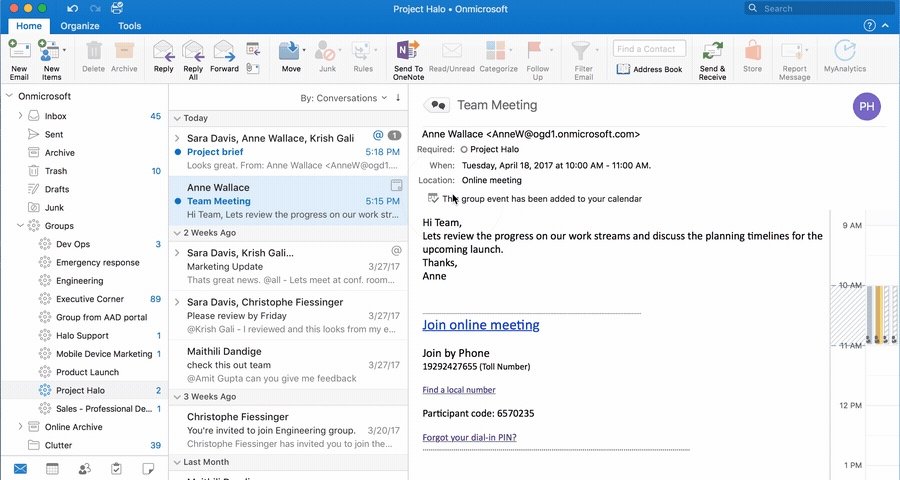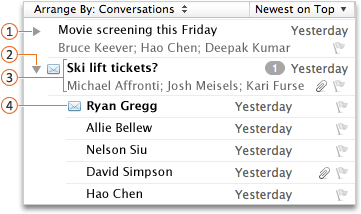

- Remove conversation view in outlook for mac how to#
- Remove conversation view in outlook for mac upgrade#
Instead, it contains the name of the person who started the conversation and the subject. The very top message is the conversation header, and it isn’t a message. These are initially hidden under the top message, with a triangle to the left side to denote that there is a thread below.Ĭlicking on the triangle expands the thread and show the emails. What Does Conversation View Do?Ĭonversation View arranges your messages into a thread in chronological order, with the newest message on top. To turn Conversation View off entirely, switch the View > Show as Conversations option off again. Try switching on “This Folder,” which will give you a chance to see if you like it before turning it on everywhere. Outlook displays a confirmation message that gives you the option to turn on the view in every folder (“All Mailboxes”) or just the current folder (“This Folder”).

To turn it on, switch on the View > Show as Conversations option. You can turn the Conversation View on and off via a simple toggle, so if you try it and don’t like it, it’s easy to turn it back off.
Remove conversation view in outlook for mac how to#
Better late than never! How to Toggle the Conversation View On and Off Let’s take a look at how to turn Conversation View back on and what customization options you have. It’s turned on by default in the Outlook web app as well, so it’s more well-used there, but for plenty of people, the Outlook client is their main email app. One of our geeks turned it off five years ago in Outlook 2013, and it’s still off now that they’re on Outlook 2019.
Remove conversation view in outlook for mac upgrade#
Also, if you turned it off in your old version of Outlook, it stays off when you upgrade to a new version. Since Outlook 2013 it’s been switched on by default, but in many businesses, it’s still turned off by default by the IT department. No matter, Outlook 2010 got it, and it was a decent effort that has worked well in all iterations since. This might seem a bit late, seeing as their previous version came out 3 years earlier (Outlook 2007), but one can only assume that it took the product managers at Microsoft a while to realize just how popular Gmail’s threaded conversation view was, by which point it was too late to add it to 2007. Microsoft got on the case and added a proper Conversation View-one that pulls emails from all folders-when they rolled out Outlook 2010. So some convoluted workarounds were fashioned using dynamic search folders, but this was all a bit crude compared to the AJAX-powered ease of Gmail. Such was the demand that suddenly everyone was talking about how to use the “Conversation” column to group emails in Outlook 2003, although this only picked up mails in the same folder.

This is a pity because Conversation View is a handy feature that a lot of people wanted after seeing conversation threading in Google’s new Gmail, which debuted in 2004/5. After all, when was the last time you looked for and read through the “new features” article on an app you use? In Outlook 20, you can apply the view settings of specified folder to other folders with clicking the Change View > Apply Current View to Other Mail Folders on the View tab.Although Microsoft talked up the Conversation View a lot when they introduced it, most people outside of corporate IT departments and readers of high-quality tech websites probably weren’t aware of it. Up to now, the specified style of grid lines has been changed between all email messages in the specified folder. Step 5: Click all OK buttons in each dialog box. To change styles of grid lines between email messages, please select one of Small dots, Large dots, dashes, or Solid. To hide grid lines between email messages, please select the No grid lines. Step 4: In the Other Settings dialog box, please click the Grid line style: box, and select one of grid line style in the drop down list. Step 3: In the popping up dialog box, please click the Other Settings button. In Outlook 20, please click the View Settings button on the View tab.In Outlook 2007, please click the View > Current View > Customize Current View.Step 2: Open the Advanced View settings dialog box: Step 1: Shift to the Mail view with clicking the Mail in the Navigation Pane, and then select the mail folder in which your will view grid lines between email messages. To display, hide, or change styles of grid lines in mail list of Microsoft Outlook, please do it as following:


 0 kommentar(er)
0 kommentar(er)
